Sake Sushi
A Comprehensive Overview of Salmon in Japanese Sushi Cuisine
サケ(サモン)すし 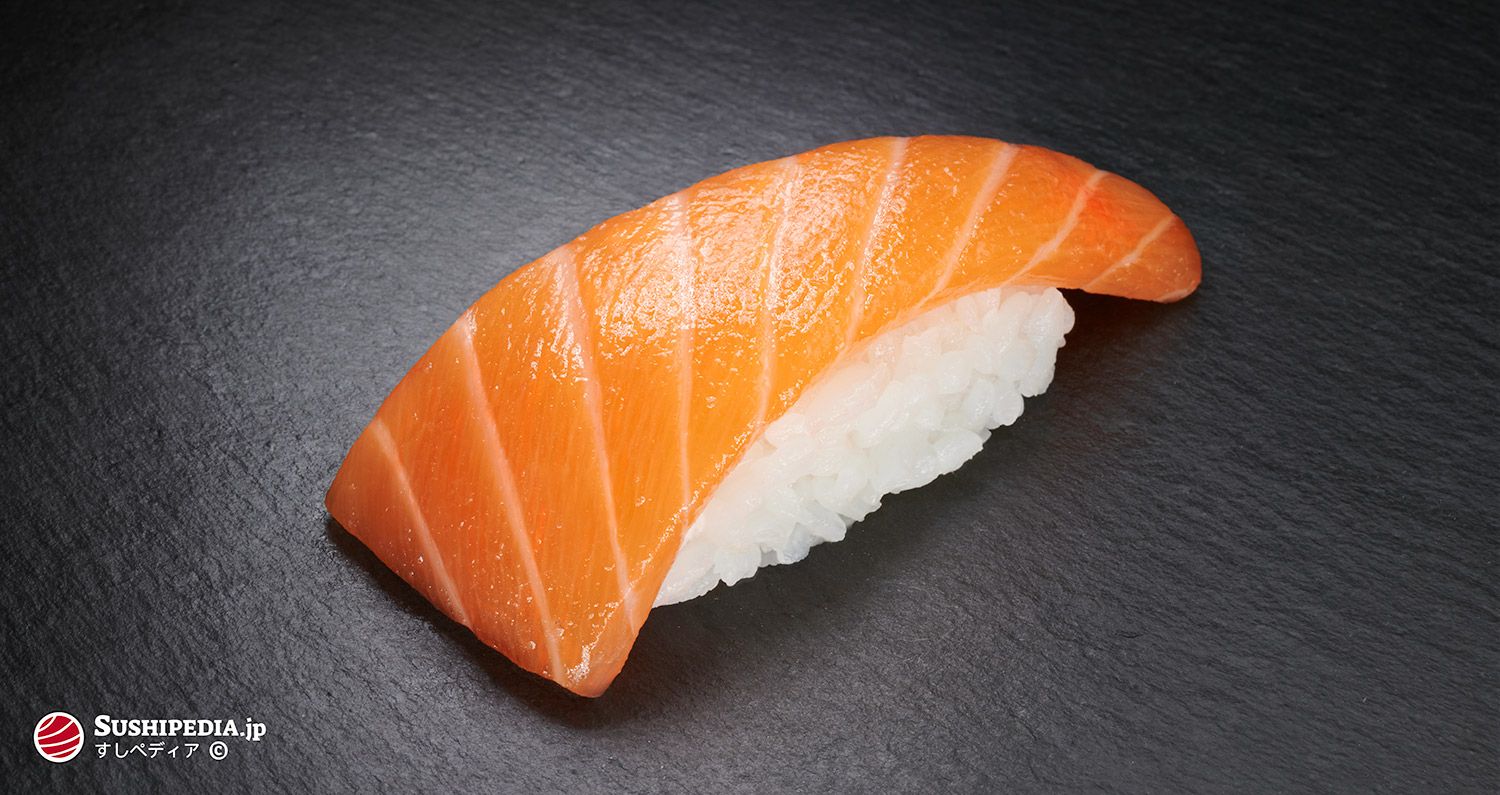
What is Sake or Sāmon?
Sake-rui サケ類 denotes the category of fish within the Salmonidae family in Japanese terminology. Specifically, the term sake primarily identifies Pacific salmon, with a particular emphasis on chum salmon known as shiro sake シロザケ. More broadly, sake encompasses a group of salmon species characterized by meat that mirrors the chum salmon in both color and texture. These species are traditionally grouped under the sake classification based on their life cycle, predominantly spent in marine environments.
Only since modern times, salmon is prepared as sushi to the extent we know it today. Traditionally, salmon was rarely used for the preparation of sushi or sashimi. Even though the term sake traditionally refers to Pacific salmons, today it is mainly the Atlantic salmon from aquaculture that is used. Salmon is one of the most popular ingredients for sushi and sashimi these days, especially outside Japan. In Japan, imported salmon is often referred to as sāmon サモン rather than sake サケ when used for Sushi or Sashimi.
Sake for Sushi or Sashimi
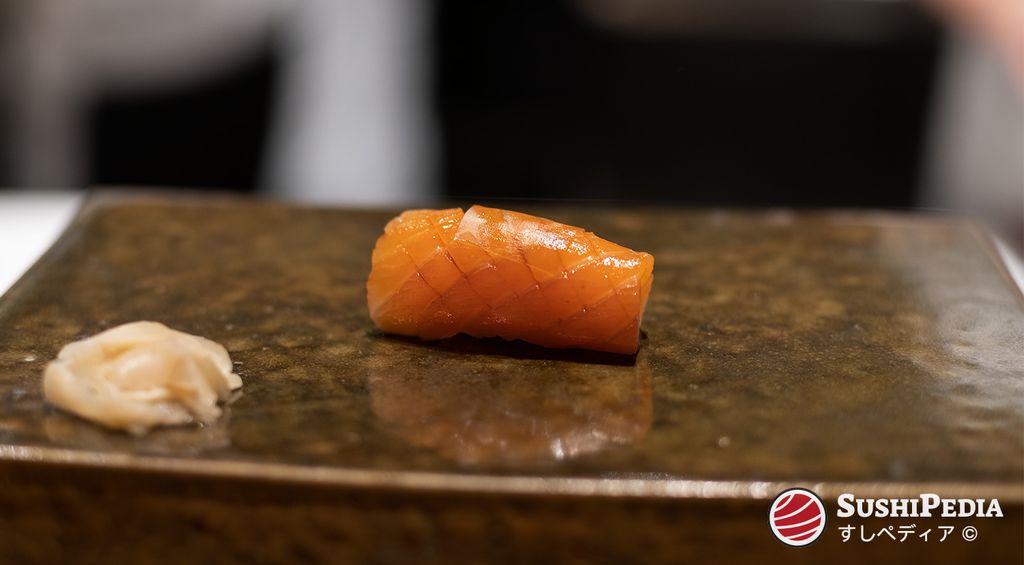
SushiPedia. Salmon Nigiri Sushi with Konbu. All rights reserved ©
Salmon and trout fish are nowadays found in many common sushi restaurants, whereas purists and high class sushi restaurants refrain from preparing sake for reasons of tradition as well as its reputation as a cheap fish.
Nevertheless, salmon is nowadays considered a popular sushi ingredient, appreciated for its umami flavor and slightly sweet aroma. Responsible for the taste is the composition of minerals, fatty acids, amino acids and volatile compounds. Salmon meat contains relatively large amounts of omega-3 unsaturated fatty acids. Essential fatty acids are certain polyunsaturated fatty acids that the body needs but cannot produce itself. They must be ingested with food. Studies suggest that the intake of omega-3 fatty acids minimizes the risk of developing atherosclerosis and the resulting cardiovascular diseases.[1]
In addition, the fat in raw salmon provides a tasty, buttery flavor. Responsible for this is inosine monophosphate (IMP, inosinate). IMP, an important component of the umami taste of fat, has a characteristic, slightly salty-sour taste accompanied by a subtle sweetness. When consumed, it stimulates the release of hormones in the brain that may be responsible for the sensation of pleasure associated with consumption. The higher the IMP content in the fat, the tastier and more aromatic it is. Fat is a significant component of texture and gives salmon its characteristic moist, soft texture. Most of the fat is found in the belly meat, which protectively surrounds the fish's organs. The fat content of salmon meat can be influenced by a number of factors, including the species of fish, age, diet, and environment.

SushiPedia. Sake Toro Nigiri. All rights reserved ©
The characteristic color of salmon meat is striking. Depending on the species, origin and food, the color palette ranges from a pale pink to a rich red to a light shade of orange. The actual color of the salmon meat is grayish, it gets its distinctive color from the composition of the food it consumes. Salmon prefer beside small fishes, especially amphipods and shrimps. These in turn feed on green algae, which produce xanthine, a natural reddish-purple dye. This dye accumulates in the meat of the salmon fish and gives it its unmistakable color. The meat is greasy, extraordinarily tender and is accompanied by intense buttery flavors. The intensity and texture of sake meat differs between species and also whether they are farmed or wild. For the preparation of sushi or sashimi, it is recommended to prefer hand-filleted salmon to that from industrial processing. Visible cracks in the meat are caused by the partial or fully automatic extraction of the standing bones. These are not only visually unattractive, but also provide an environment for bacteria. Condensation water can collect in the cuts and cracks, which promotes the reproduction of bacteria during the decomposition process. For the preparation of sushi or sashimi, the middle or front piece of a salmon side from a freshly hand-filleted specimen is best suited.
By sprinkling the pieces with a some salt after filleting, called furijio, and then storing them in a cool place for up to 30 minutes, the meat loses moisture and some odor. In turn, the texture becomes firmer, and the flavor intensifies.[2]
Best season
Depending on the species of salmon, the spawning time varies according to the region to which they return to lay eggs. Basically, one can say that the cold season is the best time for wild caught specimens. Salmon from aquaculture, on the other hand, is available all year round in consistent quality.
The red color of the salmon meat
The meat of salmon contains relatively high amounts of a natural red-purple pigment, called Astaxanthin. This pigment influences not only the taste, but especially the color of the meat. Depending on the astaxanthin content, the coloration can range from red to pink to gray. Astaxanthin not only provides the desired color, but has been shown to have other biological and nutritional functions that are important for salmon growth and health. Wild salmon absorb astaxanthin in their natural diet. Farmed salmon, on the other hand, have it added to their feed meal. Without this additive, the meat would have a gray, less appealing color.
The coloration of salmon flesh is considered an important factor in purchasing decisions and quality assessment. Consumers tend to perceive dark red meat as fresher, tastier, higher quality and more expensive. Research found that a salmon with a dark red color (33 on the SalmoFan scale) was preferred over lighter meat (22-24) by a ratio of 2:1. In addition, consumers indicated that a salmon meat with a lighter color should be less expensive than dark-colored salmon meat.[3]
Wild capture vs. aquaculture
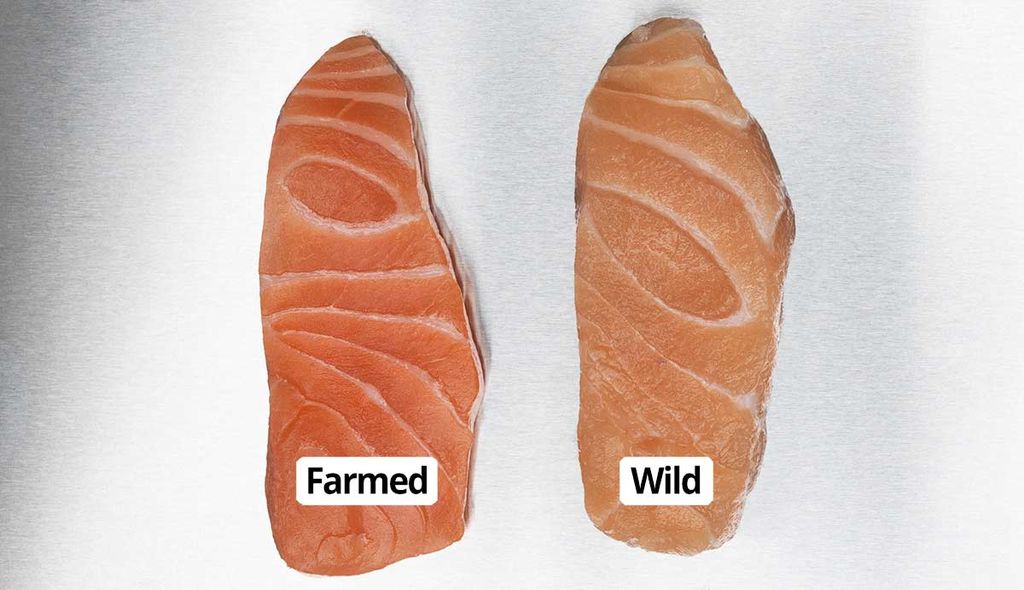
SushiPedia. Comparison of Farmed and Wild Salmon Fillets. All rights reserved ©
Salmon meat has a distinctive and strong flavor regardless of whether they come from farmed or wild stocks. The meat of salmon from aquaculture is usually richer in fat than that of wild caught salmon. Especially during summer, farmed salmon is higher in fat and accordingly tastes richer than wild salmon. The taste of the meat of wild salmon, on the other hand, is more aromatic and complex.
It is not always possible to distinguish between farmed and wild salmon by color, the shade of the meat does not always provide a valid indication, as it can be controlled by the addition of colorants in the feed. In most cases, the meat of farmed salmon has a visibly higher fat content of the muscle separating layers, which makes the characteristic light-colored stripes of the tissue appear wider and brighter. However, the actual difference is smaller than is often claimed in the popular literature, since for an adequate comparison, identically cut fillets of fish of the same age from the same species are rarely used.
With regard to raw consumption, i.e., the preparation of sushi and sashimi, it is recommended to choose sustainable and high quality farmed salmon. When wild salmon is used, it is recommended that it be prepared from pre-rigor deep-frozen salmon that has been thawed before preparation. The complete freezing process kills all parasites, but they remain in the meat.
Origin
Various sources, be it chefs, fishmongers or advertising brochures, claim that farmed salmon from Scotland or Ireland is more valuable than Norwegian salmon or vice versa. The above countries can be interchanged at will with other major industrial salmon farming nations in such advertising claims. If it is the same type of salmon, mostly Atlantic salmon, this assessment is purely subjective. The quality of the salmon is largely dependent on the expertise of the farm or producer and is influenced by various factors, such as the composition of the feed, chemical use, stocking density and water quality.
A good indicator of high quality can be, but does not necessarily have to be, the certification of the farm with an organic or ecological label.
Types of Sake
Atlantic Salmon

Timothy Knepp. Illustration of Atlantic Salmon. U.S. Fish and Wildlife Service. Some rights reserved: Public Domain
Atlantic salmon, in Japanese taiseiyou sake, is the economically most important salmon species, whose wild stocks were heavily overfished for decades. Today, almost 100% of all commercially traded Atlantic salmon comes from farms, the majority of which come from Norway and Chile.
Farmed Atlantic salmon has a high fat content and is milder in taste compared to its Pacific relatives. The consistency and texture of the meat depends on the quality of the farms and the meat processing. It is estimated to be one of the most widely used salmon species in the world for the preparation of sushi or sashimi.
Red or Sockeye Salmon
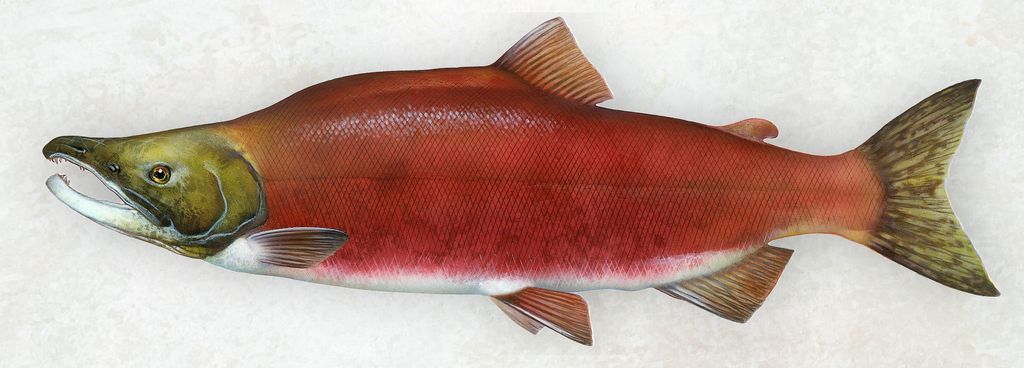
Timothy Knepp. Oncorhynchus Nerka - Portrait of a Sockeye Salmon in Spawning Colors. U.S. Fish and Wildlife Service. Some rights reserved: Public Domain
The sockeye salmon, benizake in Japanese, is only available as a wild catch. There is no commercially relevant aquaculture. The name is derived from the fact that its skin changes its color from light silver to a bright red during its migration upstream to spawn. The English name “sockeye” is an Anglicization of suk kegh (sθə́qəy̓), its name in Halkomelem, the language of the Indian tribes at the lower reaches of the Fraser River and means “red fish”.[4]
Thanks to its dark red, firm and juicy meat, red salmon is a very popular ingredient, especially when smoked or salted. Red salmon enjoys a very good reputation in top gastronomy and is accordingly traded at high prices. Even though red salmon is rarely used for sushi or sashimi, its meat is excellent because of its good taste. Thanks to its firm structure, the meat retains an appealing texture even after freezing and thawing, which is essential for raw consumption, and rewards with a full-bodied but not overly intrusive taste.
Chum, Keta or Dog Salmon
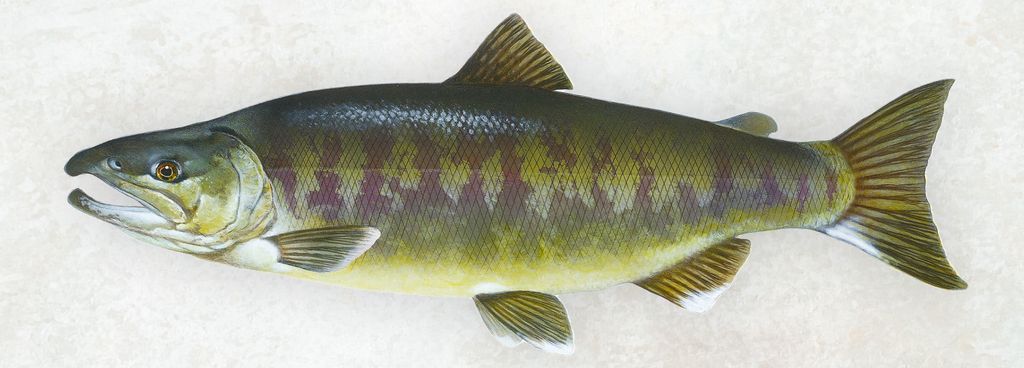
Timothy Knepp. Oncorhynchus Keta - Chum Salmon Portrait. U.S. Fish and Wildlife Service. Some rights reserved: Public Domain
In Japan, the term sake traditionally refers to the chum salmon, whose name comes from the Chinook jargon tzum, which means “spotted”, while keta comes from the East Siberian language of the Evenks. Although its name in Japanese is actually shirozake, the Japanese traditionally refer to him when they mention sake. In Japan, juveniles of the chum salmon are called keji ケイジ and have a particularly high fat content. Chum salmon caught between May and July are called tokishirazu トキシラズ or tokizake 時鮭 and are considered the tastiest. Shirozake that are about to spawn are called bunazake ブナザケ and are very popular because of their roe. Of all the salmon species, the roe of chum salmon, is considered the most prized for making ikura.
The chum salmon meat is light to medium in color and has less fat than that of other salmon species. The fat content depends on the season and the size of the animal. Besides imported Atlantic salmon from aquaculture, the solely wild caught chum salmon is the salmon most commonly used for Sushi in Japan. To kill possible parasites, the wild caught chum salmon must be frozen sufficiently.
Chinook or King Salmon
The biggest type of the Pacific salmon is the chinook salmon, whose Japanese name is Masunosuke or Kingusāmon. The chinook salmon is valued mainly for its comparatively high fat content and correspondingly tasty meat. A small number of chinook salmon are caught during their migration along the Pacific coast off Hokkaido, the largest catch areas are in the North Pacific and Alaska. More than 80% of the world's chinook salmon is aquaculture, the majority of which is produced in New Zealand.
The chinook salmon has the reputation of being the tastiest of the Pacific salmon species, next to the red salmon. The meat is very tender, full-bodied in taste and has an appealing intense coloration. For those who prefer sake sushi or sashimi with an intense and buttery taste, chinook salmon is an ideal ingredient.
Pink or Humpback Salmon
The humpback salmon owes its name to the high hump, that the sexually mature male fish develop between the head and the back-fin at the spawn-time. The males develop a strong pink coloration during the mating season, which is why they are also called pink salmon. The spread-area stretches over the coast-regions of the North-Pacific, from Alaska over California as far as to Russia and Japan. From its Japanese name karafutomasu it can be seen that the pink salmon is traditionally counted among the trout (masu) in Japan, while its modern name in Japan is pinkusāmon.
Compared to other salmon species, the pink to orange colored meat is comparatively lean and milder in taste. Over 99% of the pink salmon is caught wild. Russia and the United States of America are among the largest fishing nations. The meat of the pink salmon is rarely used in Japan for the preparation of sushi and sashimi. Most of the salmon caught in Japan is processed into canned or salted trout (shio masu 塩マス).
Silver or Coho Salmon
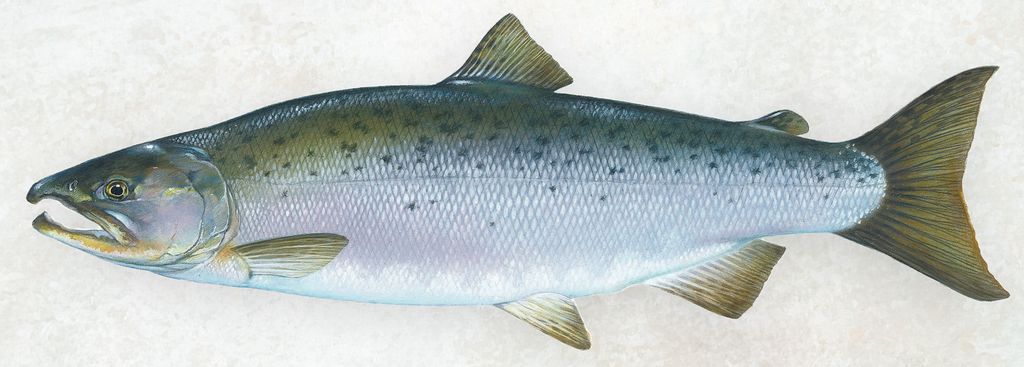
Timothy Knepp. Oncorhynchus Kisutch - Coho Salmon Portrait. U.S. Fish and Wildlife Service. Some rights reserved: Public Domain
Coho salmon, known in Japan as ginzake, are appreciated by many chefs and cuisines, whose populations are regarded as overfished. The natural habitat of the coho salmon extends along the North Pacific coasts from Japan to Russia and California. More than 85% of the world's coho salmon comes from aquaculture, the vast majority of which, almost 90%, is farmed in Chile.
In Japan, coho salmon is a popular substitute for chum and sockeye salmon, which is mainly used as salted fish, fillet and as filling for rice balls. The meat of farmed coho salmon is greasy, tasty and has a very pleasant smell and is well suited for the preparation of sushi and sashimi.
Masu Salmon
The masu salmon (sakura masu サクラマス), scientifically known as Oncorhynchus masou, is a species of salmon that is primarily found in the waters of the western Pacific, particularly in Japan, Russia, and Korea. This species is characterized by its special adaptability to different habitats, as it can survive in both fresh and salt water. This behavior distinguishes it significantly from other salmon species, which are usually born in freshwater, spend a large part of their lives in the sea and only return to fresh water to spawn.
Masu salmon are known for their striking coloration, which becomes even more intense during the spawning season. They reach a moderate size and are particularly prized in the kitchen for their tender, slightly sweet meat. In Japan, where the masu salmon is known as sakura masu, it is used in a variety of dishes, but less commonly as sashimi and sushi to grilled and smoked preparations.
In terms of fishery, masu salmon is important in both wild fisheries and aquaculture. In recent years, increased efforts have been made to develop and introduce sustainable fishing methods and farming practices. These efforts are aimed at protecting natural stocks while ensuring the availability of this salmon species for consumption.
Sea, Coastal or Salmon Trout
The sea trout is a trout caught in the sea or farmed, whose meat is pink, orange to red in color. The name applies to varieties of the brown trout (Salmo trutta) and rainbow trout (Oncorhynchus mykiss). The steelhead trout is an anadromous form of the coastal rainbow trout or brown trout, which is very popular among chefs. The coloration of the meat is a result of the food consumed by the fish, which is attributed to the composition of certain crustaceans in the case of animals caught in the sea. In the case of farmed fish, it is due to the addition of colorants in the feed.
Salmon trout, especially from maritime breeding, are popular for the preparation of various dishes and serve to a certain extent as a substitute for salmon. The farmed salmon trout is richer in fat than the common trout, but leaner than the salmon, and therefore also suitable for the preparation of sushi and sashimi.
Sake in Japan
Traditions are deeply rooted in Japanese culture and are a source of pride and identity for many sushi chefs. To guarantee their customers the best taste and consistency, the majority of sushi chefs in Japan take great care to use the freshest ingredients possible. Regional or national origin, with which also comes a kind of prestige, thus plays an important role in the selection of high quality food as an ingredient for sushi or sashimi. In addition, wild-caught fish is strongly preferred over aquacultured fish in terms of quality and taste. Thus, the fact that most salmon in Japan is imported from overseas and also comes from farms contradicts the doctrine of many discerning sushi chefs. Similarly, wild salmon is considered susceptible to infestation by parasites potentially harmful to humans. To render these parasites harmless, salmon was always heated in pre-industrial Japan and is now considered an ingredient in some traditional Japanese dishes.
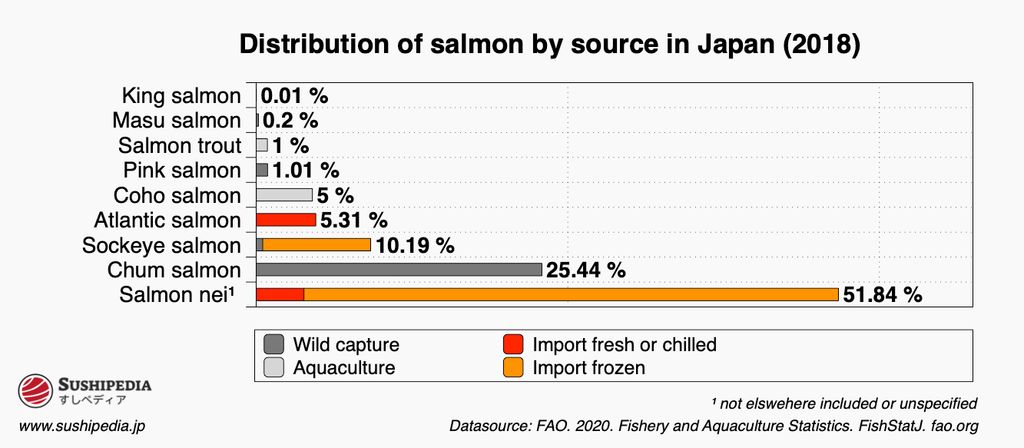
SushiPedia. Distribution of salmon species in Japan by origin in 2018. All rights reserved ©
The introduction of industrial refrigeration has made it possible to import and safely consume salmon. However, many high-end restaurants in Japan still choose not to use imported farmed salmon. However, it can be observed that salmon is becoming increasingly popular in inexpensive Japanese sushi restaurants.
Project Japan: How the Atlantic Salmon Came to Japan

SushiPedia. Aburi Salmon Sushi – Lightly Torched Sake Nigiri. All rights reserved ©
The success of salmon as ingredient for sushi or sashimi in Japan can be traced back to a joint project between Norwegian industry and the Ministry of Fisheries. The initiation of “Project Japan”, a carefully executed marketing campaign to establish Atlantic salmon in Japan, laid the foundation for the current popularity of sake sushi and sashimi.
Everybody said ‘we do not eat raw salmon.’ We had to really fight to introduce salmon into the market […] It took 15 years from when the first salmon went to Japan (in 1980) to the breakthrough for raw consumption in 1995.
Nortrage.com[5]
Due to the increasing production of farmed salmon, Norway faced a rapidly growing production surplus in the early 1980s. In Japan, on the other hand, the demand for high-quality fresh fish, especially tuna, for the preparation of sushi or sashimi increased at that time. Japanese and Russian chum salmon were already used in large quantities for smoking, salting and drying, but not for raw consumption. At the end of the 1980s, Norway invested large sums in campaigns to inform Japanese consumers, food retailers and gastronomes about the taste benefits of their product. Until then, salmon in Japan had been considered unsuitable for raw consumption and susceptible to parasites that are harmful to humans. In the long term, the campaign paid off, as salmon sushi is now considered a popular dish in Japan, and with the international rise of sushi in the 2000s, the demand for salmon from aquaculture increased immensely, not only in Japan.
Murakami: An Old City Rich in Salmon Culture
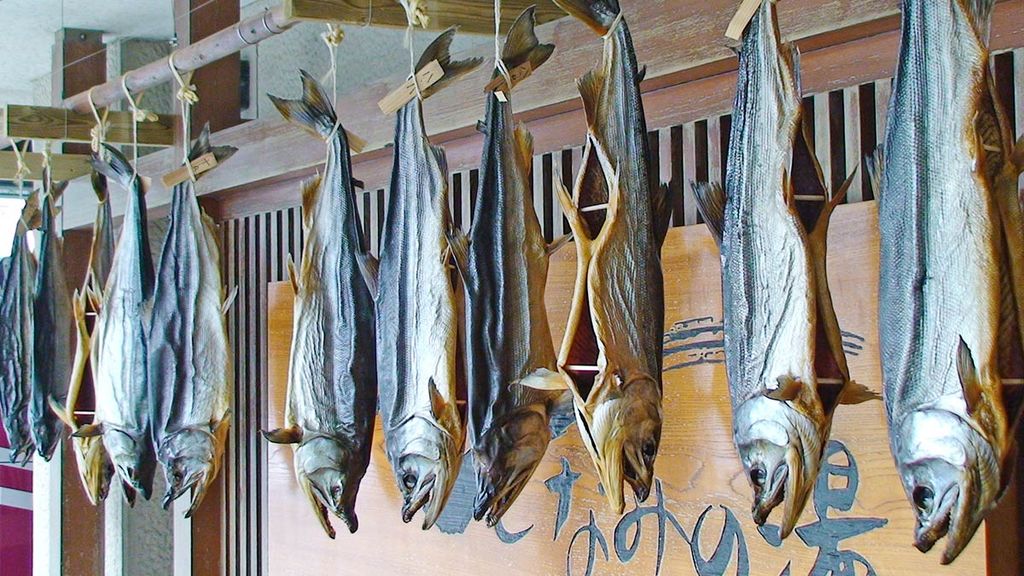
toddle. Senami hot springs. commons.wikimedia.org. Some rights reserved: CC BY-SA 3.0 DEED. Changes applied: noise, crop
Murakami 村上市 is a small ancient town in northern Niigata Prefecture, northwest of Tokyo. The city once flourished as a castle town of the Murakami clan, and even today there are remnants of samurai and trading towns in the city. It is also known beyond its borders for its salmon fishing and tea growing. The connection between salmon and Murakami is deeply rooted. As early as the Engishiki, a 10th century document, there are records of salmon catches from the region. In the Edo period (1603-1868), salmon became a valuable source of finance for the Murakami clan. According to records, a record catch of 740,000 salmon was recorded in 1884. The Murakami Salmon Museum (Iyoboya Kaikan イヨボヤ会館), is another attraction for travelers who want to learn more about Murakami salmon. The museum is the central facility of the local park, located on the banks of the Miomotegawa River. Iyoboya is the word for salmon in the Murakami dialect. Visitors can learn more about Miomotegawa River at Iyoboya Kaikan, something about the history and culture of salmon and how it is linked to the region and history of the area. Depending on the season, visitors can also watch salmon spawning and hatching.[6]
Even today, thousands of salmon are caught each year in the local rivers and dried, salted and hung in the streets and courtyards. At Kikkawa (きっかわ), a historic salmon shop in the middle of town, visitors can watch the hanging of large quantities of salmon at various stages of maturity throughout the year. There is also information about the salting process and the opportunity to taste different flavors of salted salmon. The region is also known for a tradition known as sake bitashi 酒びたし, which combines Murakami culture with a love of sake 酒, an identically written and very popular type of alcoholic drink, and salmon. Thinly sliced dried salmon is dipped in or doused with alcohol. The umami of the salmon melts into the sake and gives it a unique flavor, the natural umami flavors of the salmon are enhanced, and the meat becomes juicier.
Sake or Shake?
The terms' sake サケ and shake シャケ have both been used historically. The Waei Gorin Shusei published in 1867 lists both sake and shake, with the entry for shake noting “same as sake”. Additionally, shake was perceived as a colloquial form, as evidenced in the Shiben Nihon Jisho Kainai, a Japanese dictionary of 1889, which includes entries for both with annotated that shake is as a dialectical variant of sake. The Japanese Committee on Broadcasting Terms discussed standards for the use of both terms in 1935 and 1938 and finally agreed on sake as the standard, although shake was accepted as an alternative. While sake is generally considered the more orthodox term, there is a tendency to differentiate between the two based on context, especially when referring to the ingredient in food. A survey conducted in June 2021 states that sake is overwhelmingly used to describe the fish when it is alive and swimming, whereas shake is more commonly used to refer to parts of the fish as ingredient. In the Kanto region, responses favoring shake were notably higher than the national average for both questions. [7] At times, you may encounter the rationale that the term shake is employed specifically to prevent any mix-up with 酒, also read as sake, the well-known Japanese Alcohol, thus ensuring clarity between the two distinct items.
Sake or Sāmon?
In Japan, the distinction between sake サケ and sāmon サモン not only reflects cultural preferences but also encapsulates a significant evolution of culinary trends. Originally, sake referred to domestically caught salmon, which was typically served cooked due to the risk of parasites, making its consumption in raw form uncommon. In Japan, salmon consumption changed dramatically when imported salmon from aquaculture was introduced. This salmon, raised in controlled environments, was devoid of parasites, rendering it safe for raw consumption. Consequently, the term sāmon, a transcription of the English word salmon, is predominantly used in Japan to refer to aquaculture-derived, mostly imported, fish when prepared for raw consumption. This adaptation underscores a shift towards integrating global aquaculture advancements with traditional Japanese culinary practices.
Characteristics & Ecology of Sake

Non-disclosed author. Fresh raw trout redfish on a white table. All rights reserved ©
Salmon are native to the coastal regions and tributaries of the North Atlantic (genus Salmo) and the Pacific Ocean (genus Oncorhynchus). Some species have also been introduced by humans into non-native habitats. They are carnivores and feed in the adult stage mainly on small crustaceans, shrimps, sand eels and squid.
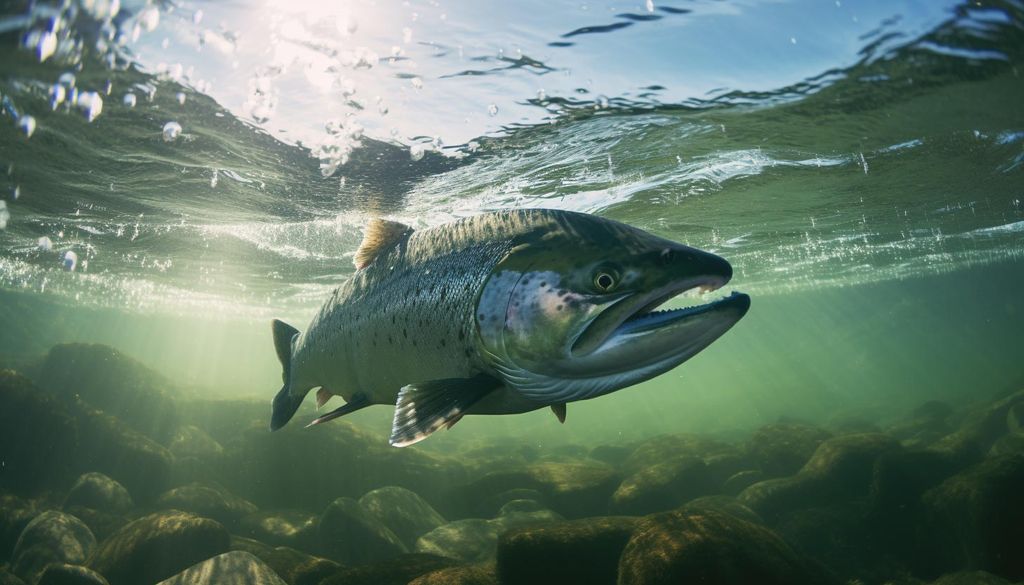
SushiPedia. Underwater View of a Salmon in a River. All rights reserved ©
Salmon belong to the anadromous fishes, whose life is characterized by a freshwater and saltwater phase. Salmonids hatch in freshwater and then migrate to the coastal sea to stay there for most of their lives, and then return to their hatching waters for reproduction. Some populations spend their whole life cycle in fresh water and in contrast to the Pacific salmon, which dies after spawning, it drives some Atlantic salmon back to the sea.
Differentiation between salmon and trout
The term “salmon” commonly refers to the Atlantic salmon of the Salmo genus, particularly in Europe. In Southeast Asia, the same term often describes related species from the same family, especially those belonging to the Pacific salmon genus, Oncorhynchus. Both these genera are part of the Salmoniformes order, which includes salmon and trout, collectively known as salmonids. The differentiation between salmon (sake) and trout (masu) is not rigid. It primarily depends on the habitat: salmon are mostly marine, whereas trout inhabit freshwater. For instance, the species O. gorbuscha, known as pink salmon, is called karafuto masu in Japanese, classifying it as a trout. Yet, some species like the Atlantic salmon migrate between fresh and saltwater. Similarly, O. masou, referred to as sakura masu or “cherry blossom trout” in Japanese, spends significant time in both rivers and the sea. The subspecies O. mykiss irideus, part of the rainbow trout family, adapts to both seawater and freshwater, and is named torauto sāmon in Japanese, meaning “trout salmon.”
Economy of Sake

SushiPedia. Global salmon production: wild-caught versus aquaculture in comparison. All rights reserved ©
The Atlantic salmon is one of the most important food fishes of all, its share of the worldwide quantity of fish from aquaculture was about 4.5% in 2018 according to the Food and Agriculture Organization of the United Nations (FAO). The increase in aquaculture production in recent years has led to a steady rise in per capita consumption rates of salmon. Driven by strong demand in almost all regions of the world, salmon has become the largest single fish product in terms of value. In terms of annual production and export volume, Norway is the global market leader, followed by Chile.
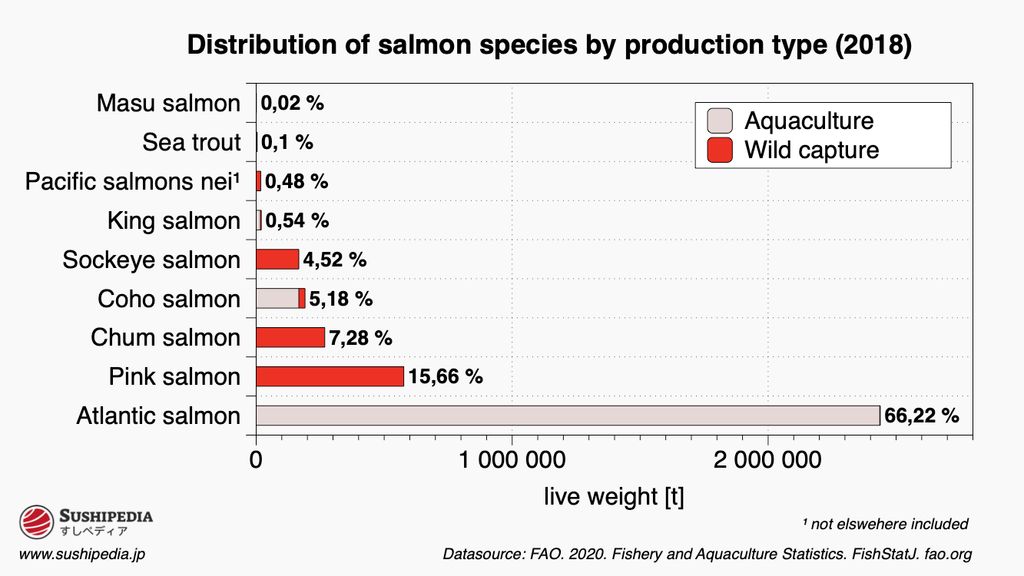
SushiPedia. Distribution of salmon species by production type in 2018. All rights reserved ©
The Risks of Aquaculture
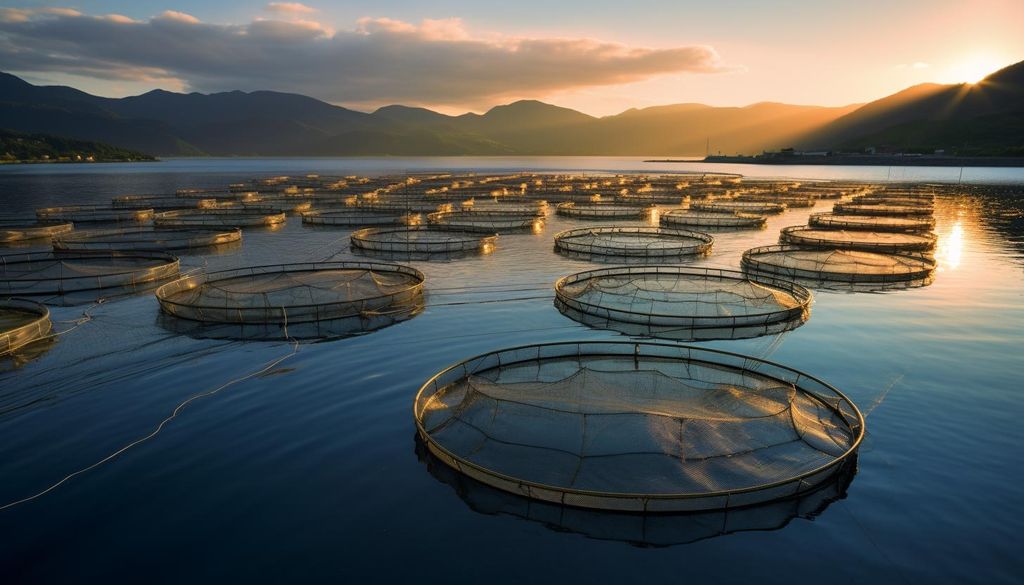
SushiPedia. Sonnenuntergang über Aquakultur-Netzen in einem Fjord. All rights reserved ©
Large industrial aquaculture operations pose a threat to wild populations of salmonids living in proximity to farms. Due to the construction design of the net cages, as well as the weather conditions in the bays, numerous salmon escape from farms every year. These escaped salmon can have a significant impact on wild relatives or other fish species. In addition to competition for food and spawning habitats, the crossing of wild and farmed salmon is considered one of the greatest threats to native wild stocks. The genetic weakening of wild populations leads to the spread of disease and the disruption or complete cessation of natural migration. Already in the 1990s, escaped farmed salmon accounted for an estimated 22% of wild catches.[8][9] In Norwegian rivers, farmed salmon represent on average between 11% and 34% of the annual spawning population.[10][11][12]
Season Calendar for Sake
The calendar shown does not provide information on fishing times, but marks the periods in which sake is considered particularly tasty.
Warnings related to Sake
Video about Sake Sushi
External video embedded from: youTube.com. Credit 東京すしアカデミー寿司職人養成学校. How to make Sushi Salmon│How to filet salmon│Tokyo sushi academy(東京すしアカデミー).
Species of Sake
The following species are regarded as authentic sake. Either historically, according to the area of distribution or according to the common practice in today's gastronomy: The term sake encompasses a variety of species that are grouped together under these names. Due to the extensive diversity of these species, it is not always possible to list all specific taxa in this list completely.
Sources and Further Reading
- [1]William S. Harris, Nathan L. Tintle, Mark R. Etherton, Ramachandran S. Vasan. Erythrocyte long-chain omega-3 fatty acid levels are inversely associated with mortality and with incident cardiovascular disease: The Framingham Heart Study. Journal of Clinical Lipidology 12 (3) 718-727. DOI: https://doi.org/10.1016/j.jacl.2018.02.010.
- [2]小野寺 桂子. 『36℃ 生 v.s. 低温調理サーモン 比較実験 (36°C raw v.s. low-temperature cooked salmon comparison experiment)』. boniq.jp, BONIQ, Hayama Shachu Co., Ltd., Kanagawa (株式会社葉山社中、葉山町)、 2020. Source retrieved 1/8/2021
- [3]Stewart Anderson. Salmon Color and the Consumer. IIFET 2000 Proceedings. 2000
- [4]William Bright. Native American Placenames of the United States. University of Oklahoma Press. 2004
- [5]Yasemin Nuhoḡlu Soysal. Asia's Transformations: Transnational Trajectories in East Asia: Nation, Citizenship, and Region. Routledge, London. 2014
- [6]iyoboya kaikan. 『村上とサケ | イヨボヤ会館 - 日本で最初の鮭の博物館 (Murakami and Salmon | Iyoboya Kaikan - Japan's First Salmon Museum)』. イヨボヤ会館. Source retrieved 3/20/2023
- [7]塩田 雄大(しおだ・たけひろ). 『「サケ」と「シャケ」どちらがよい?調査結果も-NHK (Which is better, “salmon” or “shake”? Survey results - NHK)』. NHK (Japan Broadcasting Corporation)., 2021-12-01. Source retrieved 2/22/2024
- [8]Jason Clay. World Agriculture and the Environment: A Commodity-By-Commodity Guide To Impacts And Practices. Island Press, Washington, D.C.. 2004
- [9]Don Staniford. The One that Got Away: Marine Salmon Farming in Scotland. Friends of the Earth Scotland, Edinburgh. 2001
- [10]Bror Jonsson, Nina Jonsson. Ecology of Atlantic Salmon and Brown Trout: Habitat as a template for life histories. Springer Science & Business Media, Heidelberg. 2011
- [11]Fiske P., Lund R. A., Ostborg G. M., Floystad L.. Escapes of reared salmonin coastal and marine fisheries in the period 1989–2000. NINA Oppdragsmelding 704. 2001
- [12]R. Naylor, M. Burke. Aquaculture And Ocean Resources: Raising Tigers of the Sea. Annual Review of Environment and Resources 30 185-218. 2005
- [13]Fish and Fishery Products Hazards and Controls Guidance, Fourth Edition – June 2021. U.S. Department of Health and Human Services, Food and Drug Administration Center for Food Safety and Applied Nutrition. 2021
- Andreas Kamoey. The Japanese Market for Seafood. GLOBEFISH 117. 2015
- Frank Asche, Trond Bjorndal. The Economics of Salmon Aquaculture. John Wiley & Sons, Hoboken. 2011
- Mitsutaku Makino. Fisheries Management in Japan - Its institutional features and case studies. Springer Science+Business Media, Heidelberg. 2011
- Shibusawa Keizo (言泉). Study of Japanese Fish Names (日本魚名の研究). Kadokawa Shoten, Tokyo (角川書店、東京市). 1959
- 『サケは赤身の魚ですか (Is salmon a lean fish?)』. Ministry of Agriculture, Forestry and Fisheries, Tokyo (農林水産省、東京市)、 2012. Source retrieved 12/26/2020
- IUCN Red List of Threatened Species. Version 2023-1
Image Credits
- SushiPedia. Sake Toro Nigiri. All rights reserved ©
- SushiPedia. Distribution of salmon species in Japan by origin in 2018. All rights reserved ©
- SushiPedia. Comparison of Farmed and Wild Salmon Fillets. All rights reserved ©
- Timothy Knepp. Illustration of Atlantic Salmon. U.S. Fish and Wildlife Service. Some rights reserved: Public Domain
- SushiPedia. Global salmon production: wild-caught versus aquaculture in comparison. All rights reserved ©
- SushiPedia. Sonnenuntergang über Aquakultur-Netzen in einem Fjord. All rights reserved ©
- Non-disclosed author. Fresh raw trout redfish on a white table. All rights reserved ©
- SushiPedia. Aburi Salmon Sushi – Lightly Torched Sake Nigiri. All rights reserved ©
- Timothy Knepp. Oncorhynchus Kisutch - Coho Salmon Portrait. U.S. Fish and Wildlife Service. Some rights reserved: Public Domain
- SushiPedia. Salmon Nigiri Sushi with Konbu. All rights reserved ©
- SushiPedia. Distribution of salmon species by production type in 2018. All rights reserved ©
- SushiPedia. Sake Samon Sushi. All rights reserved ©
- Timothy Knepp. Oncorhynchus Keta - Chum Salmon Portrait. U.S. Fish and Wildlife Service. Some rights reserved: Public Domain
- SushiPedia. Underwater View of a Salmon in a River. All rights reserved ©
- Timothy Knepp. Oncorhynchus Nerka - Portrait of a Sockeye Salmon in Spawning Colors. U.S. Fish and Wildlife Service. Some rights reserved: Public Domain
- toddle. Senami hot springs. commons.wikimedia.org. Some rights reserved: CC BY-SA 3.0 DEED. Changes applied: noise, crop